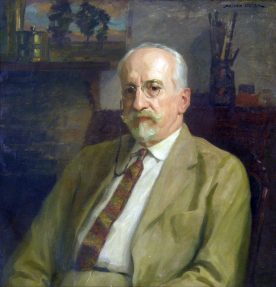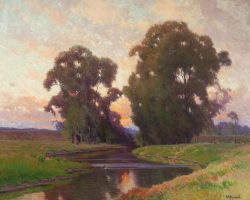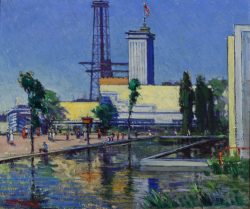Antonin Sterba, Frank C. Peyraud, undated, oil on canvas (30½ by 29⅜ inches), Brauer Museum of Art, Gift of Percy H. Sloan, 53.01.075.

Frank C. Peyraud 1858–1948
Growing up in the town of Bulle, in French-speaking Switzerland, François (Frank) Charles Peyraud wanted to become an artist, but his father encouraged him to pursue a more practical career in architecture. He trained in Switzerland and at the École des Beaux-Arts in Paris. In 1881 Peyraud went to the U.S., intending only to visit. In Chicago he applied for work as an architect in the office of William Le Baron Jenney but was rejected, reportedly because of his poor skills in English. He soon found employment instead as a painter of cycloramas and panoramas, which were at the height of their popularity in the mid-1880s, and he began studying art at the fledgling Art Institute of Chicago. Peyraud worked on several mural projects during his career. For the first one, in 1896, he teamed with painter Hardesty Maratta to decorate the new public library in Peoria, Illinois, where he also taught sketching classes until about 1900.
By the late 1880s, Peyraud was established as a landscape painter in Chicago’s burgeoning art world. He was a charter member of the Chicago Society of Artists and helped found both the short-lived Cosmopolitan Club and the Society of Western Artists. In 1888 he participated in the Art Institute’s inaugural American art exhibition. By the mid-1890s Peyraud was hailed for his “poetic” interpretations of local scenery in a modified impressionist style, often featuring dawn, sunset, or moonrise. He won the Young Fortnightly Prize for the best painting in the Art Institute’s 1899 Chicago artists’ annual show, the first of many awards that also included a Municipal Art League purchase prize in 1912 and the Art Institute’s Martin B. Cahn Prize in 1921. A resident of the Tree Studios building on the city’s Near North Side, Peyraud traveled throughout the region and the country for subjects. He worked in watercolor as well as oils.
Peyraud’s first wife, a fellow immigrant from Switzerland, died in 1899 and in 1906 he married Elizabeth Krysher, an illustrator and painter of children’s portraits; in 1919, the couple settled in north-suburban Ravinia, a section of Highland Park. During the 1910s, their travels took them as far as California and Old Lyme, Connecticut, site of a colony of impressionist landscape painters. In 1921, Peyraud returned to Switzerland, part of a three-year European sojourn. His work remained popular in Chicago throughout the 1920s, when he exhibited frequently with the Chicago Galleries Association. Solo shows of his work were presented there in 1926 and at the O’Brien Galleries in 1928. In 1935 the conservative Association of Chicago Painters and Sculptors awarded Peyraud its gold medal. Despite failing eyesight he continued painting into his last years. Widely regarded as the dean of Chicago landscape painters, Peyraud received his final solo show in 1948 at the Chicago Galleries Association. He died later that year, on the eve of his ninetieth birthday.
Wendy Greenhouse, PhD

